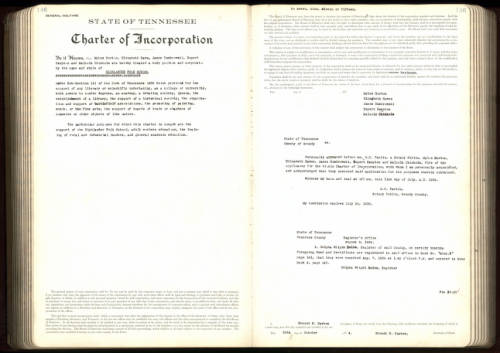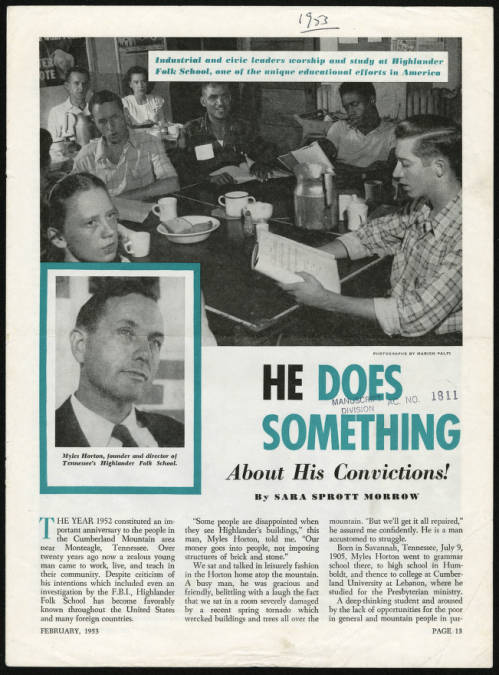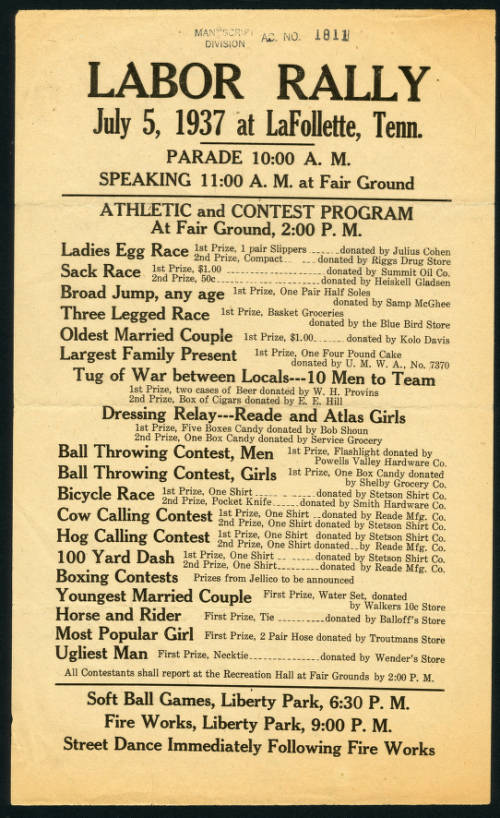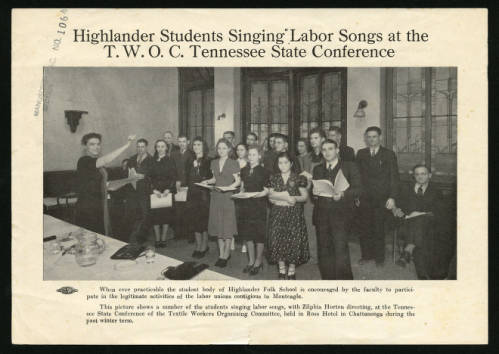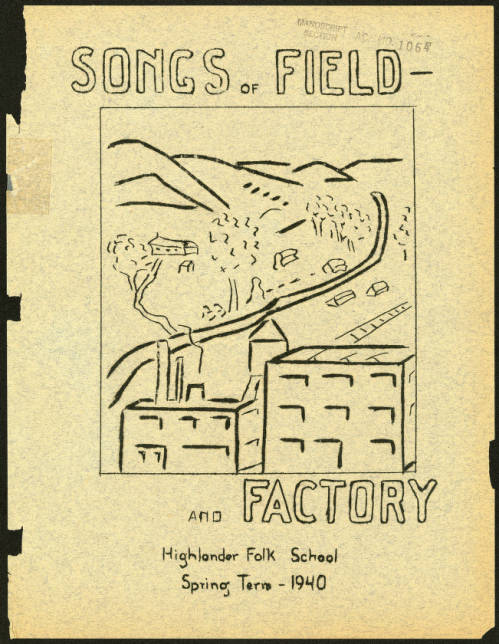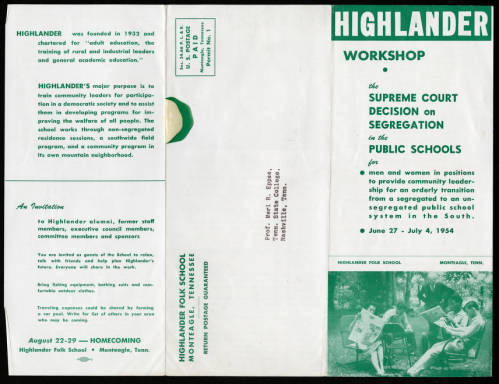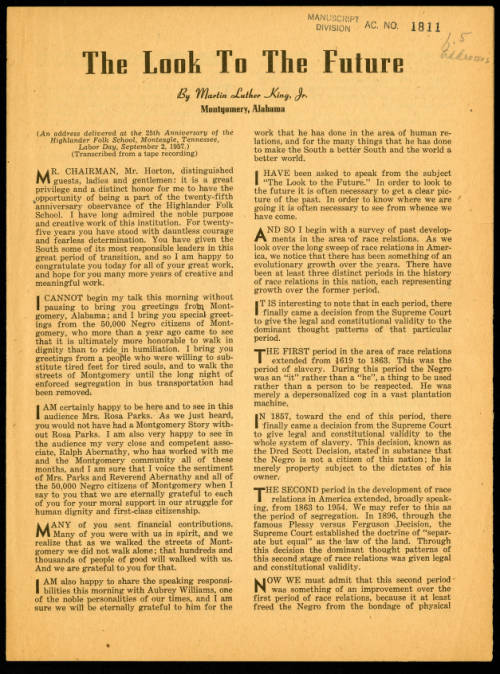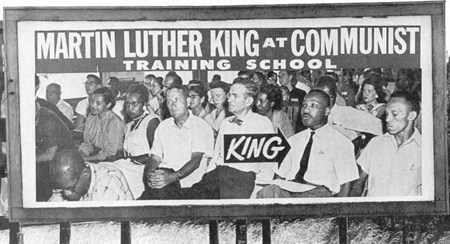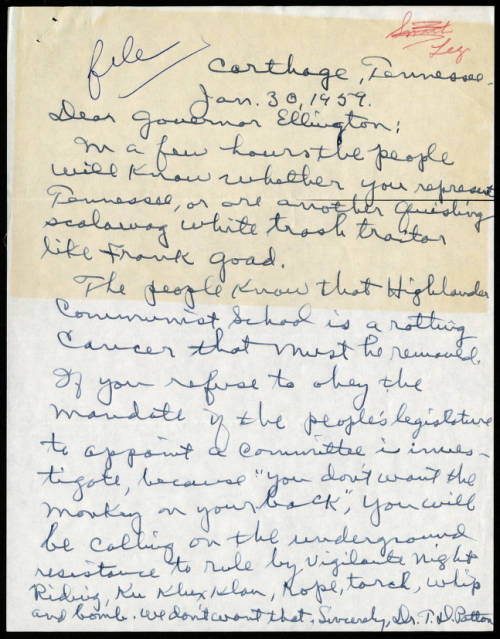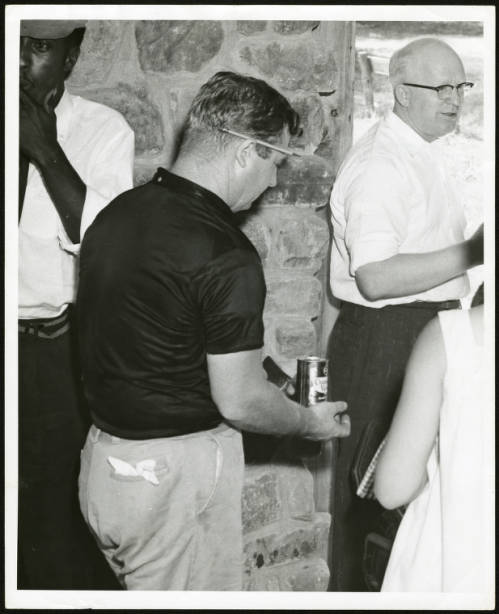Today, the Tennessee State Library and Archives launches its new digital exhibit on Highlander Folk School. Myself and a small group of colleagues worked hard to pull this together and hope everyone can learn about Highlander’s importance to Tennessee and the United States. 1/
This collection only extends to about 1961 when Highlander’s original location was shuttered due to an investigation by the Tennessee General Assembly. https://cdm15138.contentdm.oclc.org/customizations/global/pages/collections/highlander/highlander.html 2/
Highlander Folk School was established in 1932, by Myles Horton, Don West, Jim Dombrowski, Elizabeth Hawes, Malcolm Chisholm, and Rupert Hampton to train and organize Southern laborers. Here is their original charter of incorporation: 3/
The school was set up in Monteagle, Tennessee, located in Grundy County at the southern edge of the Cumberland Plateau. Dr. Lillian Wyckoff Johnson, a former professor and president of Western College for Women, donated her home for Highlander’s use. 4/
Highlander had a rough beginning, with only one student at its opening session. But Horton and Don West catered their curriculum to the community's needs and eventually the school gained a foothold after their success in the local bugwood cutters strike in 1933 to 1934. 5/
The school was unsuccessful in securing grants from state/federal government and relied almost entirely on donations as tuition only covered the students' living expenses. It wasn't until 1937 when Highlander was granted tax-exempt status that their monetary woes diminished. 5/
Myles Horton, born in Savannah, Tennessee, in 1905, served as Highlander’s director from its opening until 1969. Horton supported his high school education by working at a sawmill and box factory. 6/
He graduated from Cumberland University in Lebanon, Tenn. and attended both the University of Chicago and Union Theological Seminary, where he studied under Reinhold Niebuhr, who he agreed with on worker’s rights, education, and the rejection of corporate capitalism. 7/
In 1931, Horton traveled to Denmark to tour the country’s folk schools, on which he would base Highlander. Horton’s objective was for those “who would otherwise have no educational advantages… 8/
...to learn enough about themselves and society, to have something on which to base their decisions and actions whether in their own community or in an industrial situation…” Horton decided to open one of his own in his home state of Tennessee and Highlander opened in 1932. 9/
The 30s-40s saw Highlander train textile and industrial workers as well as union organizers across the South as an arm of the Congress of Industrial Organizations(CIO). Below is a flyer for a labor rally, one of many events hosted/sponsored by Highlander to educate organizers 10/
...in the Cumberland Plateau. This specific rally is actually featured in the film “People of the Cumberland,” which was also sponsored by Highlander. The film had two directors, Sidney Meyers and Jay Leyda, who used the pseudonyms for their screen credit, ... 11/
...and Elia Kazan served as assistant director. Watch it online here: https://www.filmpreservation.org/sponsored-films/screening-room/people-of-the-cumberland-1937 12/
In 1935, Zilphia Mae Johnson attended a workshop at Highlander where she became enamored with its director. The pair married shortly thereafter. Zilphia, was born in Arkansas, the daughter of a coal mine superintendent. Ironically, when ... 13/
...Claude Williams came to organize the miners into the Progressive Miners' Union, Zilphia related more to their plight than that of her father, for which she was disowned. She graduated from the College of the Ozarks and after marrying Horton, she became musical/drama... 14/
Horton collected songs from across the South drawing on both folk and African American musical traditions. She organized them into songbooks which she taught at workshops and to union members and picketers. 16/
Through her work, she helped organize unions and auxiliaries at a textile factory in Chattanooga, the aluminum plant at Alcoa, and in Knoxville. Below is an example of a song book compiled by Zilphia Horton. 17/
Here is an audio clip of Zilphia Horton discussing the contributions of Black Americans to our cultural heritage and singing “How Long Brethren” 18/ https://teva.contentdm.oclc.org/digital/collection/highlander/id/1900/rec/16
May Justus, whose work in Monteagle pre-dated Highlander, was Highlander’s secretary-treasurer in addition to many other roles. She was born in Del Rio, Tennessee, in the Cocke County mountains. She graduated from the University of Tennessee and published over 60 books. 19/
Here is an audio clip of Justus singing the traditional folk tune “What’ll We Do With the Baby O?” https://teva.contentdm.oclc.org/digital/collection/highlander/id/1887/rec/7 20/
Following WWII, under pressure from the rising “Red Scare” movement the CIO began withdrawing its support from Highlander. Horton saw the CIO as too reactionary and wanted to alter their education program. Thus, in 1953, Highlander’s primary focus became desegregation... 21/
and Civil Rights. While Highlander had always been interracial, it was only then that desegregation became their goal. 22/
Between 1953 and 1961, Highlander conducted workshops for organizations such as the National Association for the Advancement of Colored People (NAACP), the Congress of Racial Equality (CORE), and the Student Non-Violent Coordinating Committee (SNCC). 23/
Staff, including Septima Clark and Bernice Robinson, held workshops to train organizers and held citizenship courses to help African Americans pass onerous literacy tests in order to vote. They eventually trained teachers to expand their network across the South. 24/
The earliest pilot program for these was directed by Esau Jenkins in the Sea Islands of South Carolina. This audio clip is Jenkins explaining his work on John’s Island. https://teva.contentdm.oclc.org/digital/collection/highlander/id/1923/rec/4 25/
These citizenship schools were instructional programs both at Highlander and in the community to teach primarily poor African Americans to read, write, pass voter registration tests, and how to take advantage of community institutions such as banks and post offices. 26/
These classes helped over 50,000 people register to vote by 1964. This audio clip is Bernice Robinson explaining the birth of citizenship schools on John’s Island and Jenkins’s work. https://teva.contentdm.oclc.org/digital/collection/highlander/id/1891/rec/2 27/
In addition to field schools, Highlander ran workshops in Monteagle. Septima Clark, by now educational director at Highlander, continued desegregation workshops. In 1955, Rosa Parks attended a workshop there, shortly before refusing to give up her bus seat in Montgomery. 28/
Highlander was an important gathering place for Civil Rights organizers to meet and discuss tactics and methods. Here is an audio clip of Rosa Parks talking about the bus boycotts at Highlander in 1956.
https://teva.contentdm.oclc.org/digital/collection/highlander/id/1866/rec/12 29/
https://teva.contentdm.oclc.org/digital/collection/highlander/id/1866/rec/12 29/
In 1957, Highlander held their 25th anniversary meeting where many guests joined the festivities and workshops. The keynote speaker was Dr. Martin Luther King, Jr. whose speech discussed Black history and the new phase that began after the Supreme Court's.. 30/
decision in Brown v. Board of Education. He mentioned White Citizen's Councils and the KKK and their threats of violence on Black Americans. King viewed the next phase in the fight for equality as Black union membership and economic equality. 31/
It was at this anniversary workshop that the famous photograph of King supposedly at a communist training school was taken. This photo was used to discredit King and the Civil Rights movement and appeared in segregationist propaganda and billboards. 33/
Following their success desegregating lunch counters in Nashville in 1960, organizers Angeline Butler, John Lewis, and C. T. Vivian discussed their roles in the movement. Here is Butler: https://teva.contentdm.oclc.org/digital/collection/highlander/id/1916/rec/1 34/
Here is John Lewis speaking at a 1961 workshop at Highlander on the organization of the Nashville Sit-In movement. He emphasizes the democratic makeup of the movement. https://teva.contentdm.oclc.org/digital/collection/highlander/id/1930/rec/6 35/
And finally Rev. C. T. Vivian on the spiritual aspects of the Civil Rights Movement: https://teva.contentdm.oclc.org/digital/collection/highlander/id/1881/rec/11 36/
Highlander’s transition to Civil Rights and desegregation work attracted the eye of Georgia and Tennessee’s governments as well as segregationists more broadly. Citizens often wrote Tennessee’s governors with accusations of communist activity or threats of vigilante violence. 37/
This letter to Gov. Buford Ellington from T. D. Patton demands closure of Highlander or face “ underground resistance to rule by vigilante night riding, Ku Klux Klan, rope, torch, whip and bomb.” 38/
Both Georgia and Tennessee investigated the school and Tennessee filed suit to close the school. Most of their accusations of illegal teaching practices or communist activity were unfounded but were successful in charging the school with selling alcohol without a permit,... 39/
...based on eyewitnesses and this photograph by Georgia investigator Ed Friend, showing a man holding a beer(Champagne Velvet for those interested). (The back of the photograph is stamped with a logo that says "Brotherhood by Bayonet", a protest slogan against integration.) 40/
In 1961, the school was forced to shut down with this ruling and its charter revoked, but Horton reopened Highlander near Knoxville the following day. While this collection and thread only runs until 1961, Highlander’s work continues! @HighlanderCtr 41/
It moved to its current home in New Market in 1972. From the 1970s-90s, Highlander worked to support the people of Appalachia defending its landscape and people from destructive environmental and labor practices. Highlander has continued its mission to advocate... 42/
for worker's rights as well as human rights to this day. It is currently under the leadership of Ash-Lee Henderson and Allyn Maxfield-Steele.
Again please check out this wonderful digital collection at TSLA: https://cdm15138.contentdm.oclc.org/customizations/global/pages/collections/highlander/highlander.html
Sources: “The Coal Operator’s Daughter: Zilphia Horton, Folk Music, and Labor” by Chelsea Hodge
Glen, John M. Highlander: No Ordinary School, 1932-1962. (Lexington: University Press of Kentucky, 1988)
Highlander Research and Education Center: https://highlandercenter.org/
Glen, John M. Highlander: No Ordinary School, 1932-1962. (Lexington: University Press of Kentucky, 1988)
Highlander Research and Education Center: https://highlandercenter.org/

 Read on Twitter
Read on Twitter